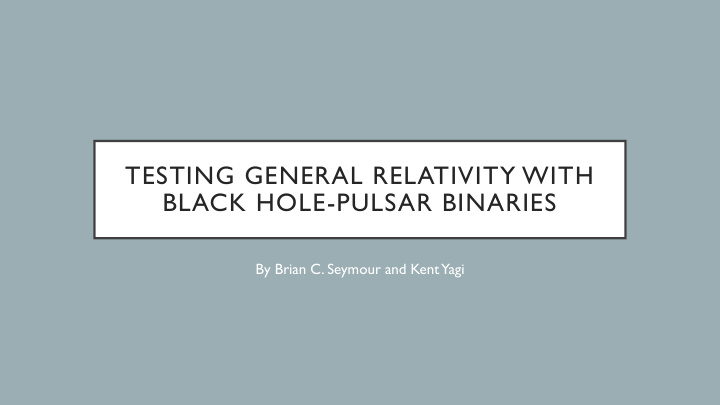



TESTING GENERAL RELATIVITY WITH BLACK HOLE-PULSAR BINARIES By Brian C. Seymour and Kent Yagi
NEWTONIAN GRAVITY • Gravitational constant is fundamental part of Newton’s formulation of gravity. ) * • G is the constant in time and equal to 6.674 × 10 '(( +, - . / ,123456 = 8 9 ( 9 : F F 9 ( 9 : 0 r ; :
• Einstein’s general relativity improved Newtonian gravity to deal with relatively strong-field experiments. GENERAL RELATIVITY • Gravitational force is caused by curvature of spacetime. • Mass distorts spacetime • Spacetime distortion moves matter
NEW STARS IN GENERAL RELATIVITY • New types of special compact stars emerge such as black holes and pulsars. • A black hole bends space so much that nothing, including light, can escape it. • A pulsar is as heavy as the sun but around the same width as Washington DC. Pulsar Black Hole
GRAVITATIONAL WAVES IN ASTROPHYSICAL BINARIES • General relativity also predicted that orbiting heavy objects emit gravitational waves (ripples of spacetime). • Gravitational waves emit energy, so stars spiral together. • This decreases the orbital period. • 2017 Nobel Prize awarded to LIGO for first direct gravitational wave detection!
EXPERIMENTAL SETUP • Radio telescopes and gravitational wave observatories have found double black hole and double pulsar binaries and are actively searching for a black hole – pulsar binary. • When one is found, observations of orbital period change will be powerful for testing general relativity. • We can test if the gravitational constant is truly constant by observing the binary. Black Hole-Pulsar Binary Radio Telescope
BOUNDS ON A CHANGING GRAVITATIONAL CONSTANT Current best bound Black hole-pulsar radio telescope observation
CONCLUSION AND FUTURE WORK • General relativity is the best current theory of gravity. • Gravitational waves have a promising powerful future for understanding our universe. • A black hole – pulsar binary will present new ways to test general relativity.
Recommend
More recommend